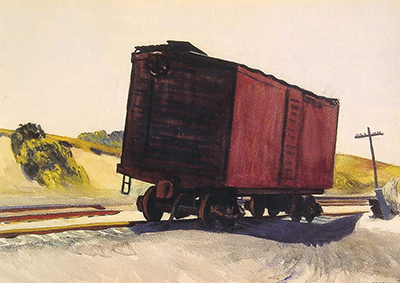Edward Hopper painted the Freight Car at Truro in 1931. As with many of his paintings during this era, he opted to use oils on canvas. Throughout his career Hopper focussed upon the everyday objects that surround us, with his paintings being dominated by the human form, buildings and vehicles.
The Freight Car at Truro at first appears to be a very simple painting. The freight train is alone on a deserted railway track and dominates the entire painting with its bold use of colour and straight lines.
The only other images on the canvas are that of a railway line, pylon and a grassy bank to the left side of the painting. However on closer inspection, it becomes clear that the painting is anything but simple.
The freight train is in perfect symmetry with its surroundings. The angle of the freight train, is leaning slightly to the right, as is the pylon and the grassy bank. All three elements seem to be working together, become one, perfectly complementing each other.
Throughout his many works, Hopper focussed very much upon the issue of social isolation and used light and dark to empathies this point. Although this was mainly used on the human form, it was also used with inanimate objects, as in this painting.
The freight train at first does appear to be abandoned, but through the clever use of light and shade, the area around the freight train appears to be in a much softer focus, almost as if it is welcoming the freight train and telling it that it is not alone, but that it is with them and the elements.
It is clear in the way that Hopper created this image, that he had a fondness for trains and items that had been seemingly forgotten and abandoned. He has brought the freight train to life again, so that its beauty can be appreciated once more.




